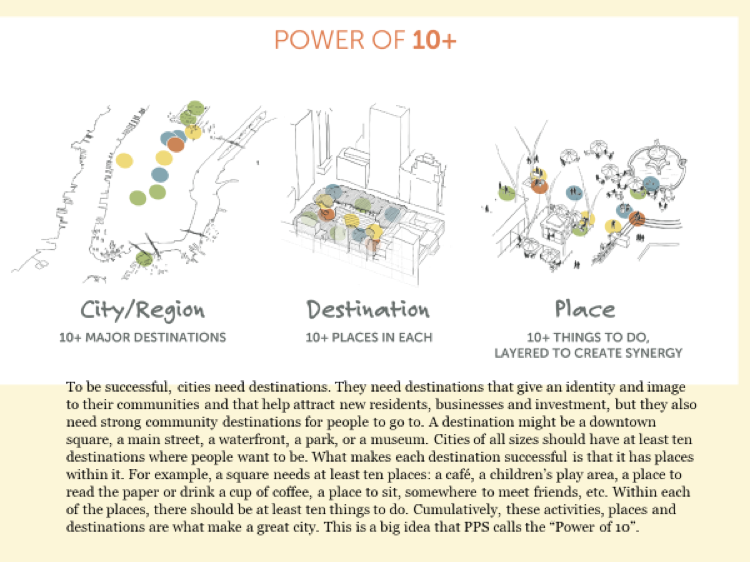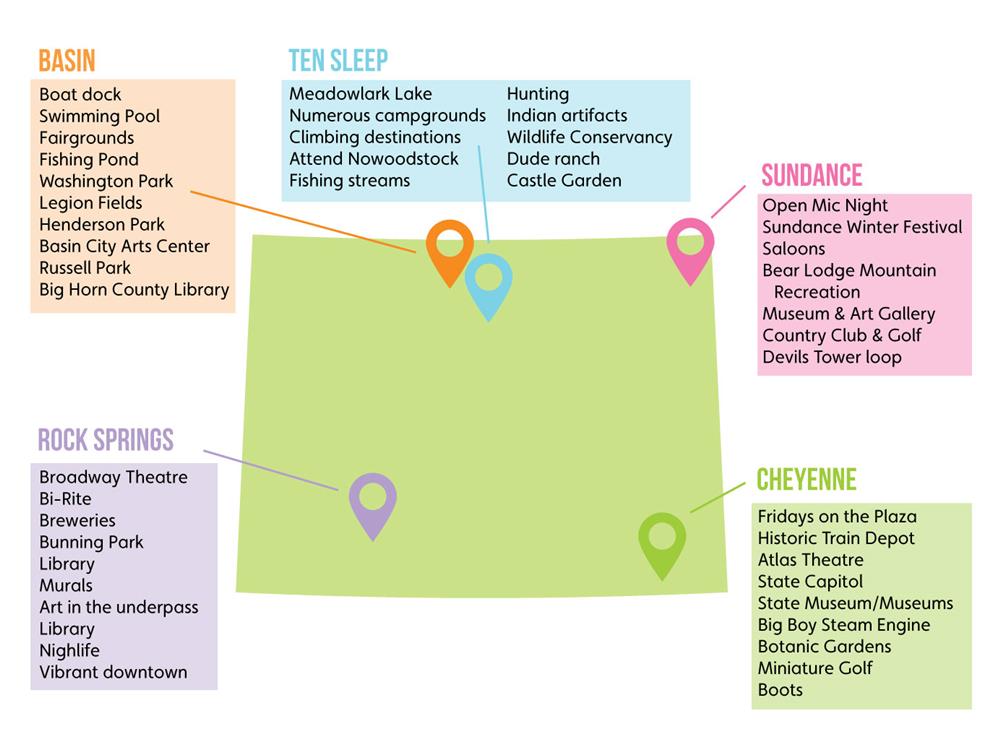Placemaking is a multi-faceted approach focused on making your community a better place to live, work, and play by transforming underutilized public spaces into vibrant community places.
Placemaking capitalizes on a local community’s assets, inspirations, and potential that contribute to people’s health, happiness, safety and well-being. As a place becomes more desirable and welcoming, people will want to spend more time there. Because of this, Placemaking can increase both the sales tax and property tax base within a community.
Turning a weedy parking lot into a putt-putt golf course. Attracting people to a little-used park to gather, play, or listen to music. Brightening up an otherwise drab vacant lot. Envisioning how a block can be revitalized. This is Placemaking.
Placemaking is a method of improving public spaces by trying your ideas out. Instead of spending a lot of money and time on a place that no one spends time in, Placemaking is “Test B4 You Invest.” It is centered around what people want – to plan, design and manage public spaces.
Placemaking is creating a common vision that can quickly evolve into an implementation strategy doing small-scale projects that bring immediate benefits to a public space that can be built upon in the future.
Placemaking can be used to improve all of the spaces that comprise the gathering places within a community—its streets, sidewalks, parks, buildings, and other public spaces—so they invite greater interaction between people and foster healthier, more social, and economically viable communities.
The Wyoming Business Council offers a four-hour interactive workshop on Placemaking. At the end of the Workshop you will:
The community’s role:
The WBC will:
Project for Public Spaces (PPS) is a nonprofit planning, design, and educational organization dedicated to helping people create and sustain public spaces that build stronger communities. Our pioneering Placemaking approach helps citizens transform their public spaces into vital places that highlight local assets, spur rejuvenation and serve common needs. Wyoming received a grant from the National Main Street Center to bring this important concept to Wyoming. Wyoming received a grant from the National Main Street Center to bring this important concept to Wyoming.
For The Love of Cities (Paul Kageyama)
Books – For the Love of Cities
Love Where You Live
Tactical Urbanism Materials & Design Guide
Community Builders, NFP, Glenwood Springs, CO
Wyoming Cultural Trust Fund – can provide grant funding for all forms of arts and culture.
National Endowment for the Arts – Our Town grants
Place-Based Projects. Through arts engagement, cultural planning, design, and/or artist/creative industry support, these projects contribute to improved quality of life in local communities. These projects require a partnership between a nonprofit organization and a local government entity, with one of the partners being a cultural organization. Matching grants range from $25,000 to $200,000, with a minimum cost share/match equal to the grant amount.
National Association of Realtors – NAR’s Placemaking Program, which includes a Placemaking guide, a series of webinars, a blog and a grant, encourages REALTOR® associations, and their REALTOR® members, to engage in Placemaking in their communities. Many Placemaking activities, often referred to as Lighter, Quicker, Cheaper, are small, inexpensive, and incremental community projects. They do not need to cost a lot of money to get off the ground. Nor do they need to take a lot of time to plan and complete. But, these smaller types of Placemaking activities can often help to improve a neighborhood and make it a better place to live, work and play.
NAR’s Placemaking Grant is available to REALTOR® associations to help them create new public spaces and destinations in their communities. The Grant has two levels. Level 1, up to $1,500, for demonstration projects and Level 2, up to $5,000 to build parks/pocket parks, trails/paths, dog parks, play/fitness areas, community gardens, and alley activations. Placemaking is all about being in the moment, in a space. This video is a great story about pop-ups, temporary events, and retail that bring life to spaces and experiences. It is connecting with people and an experience – making memories that are Instagrammable.
It’s not enough to have one great place, you need several great places to create a truly lively community. Within each place there should be 10 things to do or 10 reasons to be there. Destinations give an identity and image to the community, give residents a place to enjoy, help attract new residents, businesses and investment. Destination could be as simple as a downtown square, a main street, a park, or a museum.
Think about the special places in your communities. How many quality places are in the community, and how connected are they? Are there places that should be more meaningful but aren’t? Answering these questions can help focus your energy. This simple, common sense idea can be transformative for evaluating and strategically improving an entire city or region.

Apply the “Power of 10” on a regional scale by linking towns and cities together with major public spaces and great destinations. Partner with nearby communities to cross-promote and highlight the many places there are to visit within the region, keeping visitors in your area longer, sharing the work and the benefits.

Placemaking creates a sense of place, an emotional tie to the place. Successful Placemaking is understanding that placemaking is both about the physical place and the making of it. Residents are more informed and invested in the project and will support it. They will feel connected, making the area more economically vital. This will be a place they want to take their friends and family when they visit.
Many communities have beautiful spaces that stay largely empty. Instead of “build it and they will come,” placemaking engages citizens to decide what they would use in a space. It gets citizens motivated and energized to turn their places around. Starting small and testing ideas out, creates the momentum for citizens to be involved and invested in making their community spaces great.
At the heart of community engagement is asking what citizens (and visitors) want to see in a place. These open-ended questions may solicit create ideas that were not thought about before. Putting into place these ideas creates that place attachment. Volunteers who work on the place, creates that place attachment. Place attachment is what makes Placemaking different.